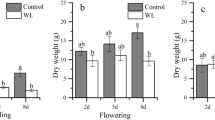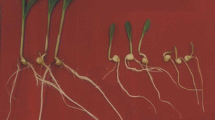Abstract
A new pressure-perfusion technique was used to measure hydraulic and osmotic properties of the outer part of roots (OPR) of 30-day-old rice plants (lowland cultivar: IR64, and upland cultivar: Azucena). The OPR comprised rhizodermis, exodermis, sclerenchyma and one cortical cell layer. The technique involved perfusion of aerenchyma of segments from two different root zones (20–50 mm and 50–100 mm from the tip) at precise rates using aerated nutrient solution. The hydraulic conductivity of the OPR (LpOPR=1.2×10−6 m s−1 MPa−1) was larger by a factor of 30 than the overall hydraulic conductivity (Lpr=4×10−8 m s−1 MPa−1) as measured by pressure chamber and root pressure probe. Low reflection coefficients were obtained for mannitol and NaCl for the OPR (σsOPR=0.14 and 0.09, respectively). The diffusional water permeability (P dOPR) estimated from isobaric flow of heavy water was smaller by three orders of magnitude than the hydraulic conductivity (LpOPR/P fOPR). Although detailed root anatomy showed well-defined Casparian bands and suberin lamellae in the exodermis, the findings strongly indicate a predominantly apoplastic water flow in the OPR. The LpOPR of heat-killed root segments increased by a factor of only 2, which is in line with the conclusion of a dominating apoplastic water flow. The hydraulic resistance of the OPR was not limiting the passage of water across the root cylinder. Estimations of the hydraulic properties of aerenchyma suggested that the endodermis was rate-limiting the water flow, although the aerenchyma may contribute to the overall resistance. The resistance of the aerenchyma was relatively low, because mono-layered cortical septa crossing the aerenchyma ('spokes') short-circuited the air space between the stele and the OPR. Spokes form hydraulic bridges that act like wicks. Low diffusional water permeabilities of the OPR suggest that radial oxygen losses from aerenchyma to medium are also low. It is concluded that in rice roots, water uptake and oxygen retention are optimized in such a way that hydraulic water flow can be kept high in the presence of a low efflux of oxygen which is diffusional in nature.






Similar content being viewed by others
Abbreviations
- A r :
-
surface area of root
- C i :
-
osmotic concentration of xylem sap
- C o :
-
osmotic concentration of medium
- δ:
-
unstirred layer
- Δπ:
-
osmotic pressure difference
- ΔP r :
-
change of root pressure
- ΔV s :
-
change of volume
- D s :
-
diffusion coefficient of solutes
- J Vr :
-
water flow
- k rw :
-
rate constant for water
- k sr :
-
rate constant for solutes
- Lp:
-
hydraulic conductivity
- LpAER :
-
hydraulic conductivity of aerenchyma
- LpOPR :
-
hydraulic conductivity of outer part of the root
- Lpr :
-
hydraulic conductivity of the root
- LpSPK :
-
hydraulic conductivity of spokes
- OPR:
-
outer part of roots
- P :
-
steady-state pressure
- P d :
-
diffusional water permeability
- P dOPR :
-
diffusional water permeability of outer part of the root
- P fOPR :
-
hydraulic water permeability of outer part of the root
- P gas :
-
pneumatic pressure
- P ro :
-
original root pressure
- P rmin :
-
minimum root pressure
- P sr :
-
permeability coefficient of solutes
- PTS:
-
trisodium 3-hydroxy-5,8,10-pyrenetrisulfonate
- Q V :
-
pump rate
- σsOPR :
-
reflection coefficient of outer part of root
- σsr :
-
reflection coefficient of root
- T 1/2 s :
-
half-time of solute exchange across roots
- T 1/2 w :
-
half-time of water exchange across roots
- t min :
-
required time for minimum root pressure
- V :
-
exuded volume of the xylem sap
- V w :
-
molar volume of water
- V x :
-
volume of xylem
References
Briones AM, Okabe S, Umemiya Y, Ramsing NB, Reichardt W, Okuyama H (2002) Influence of different cultivars on population of ammonia-oxidizing bacteria in the root environment of rice. Appl Environ Microbiol 68:3067–3075
Brouwer R (1954) The regulating influence of transpiration and suction tension on the water and salt uptake by roots of intact Vicia faba plants. Acta Bot Neer 3:264–312
Brundrett MC, Enstone DE, Peterson CA (1988) A berberine–aniline blue fluorescent staining procedure for suberin, lignin and callose in plant tissue. Protoplasma 146:133–142
Brundrett MC, Kendrick B, Peterson CA (1991) Efficient lipid staining in plant material with Sudan red 7B or Fluorol yellow 088 in polyethylene glycol–glycerol. Biotech Histochem 66:111–116
Clark LH, Harris WH (1981) Observations on the root anatomy of rice (Oryza sativa L.). Am J Bot 68:154–161
Clarkson DT, Robards AW, Stephens JE, Stark M (1987) Suberin lamellae in the hypodermis of maize (Zea mays) roots; development and factors affecting the permeability of hypodermal layers. Plant Cell Environ 10:83–93
Colmer TD, Gibberd MR, Wiengweera A, Tinh TK (1998) The barrier to radial oxygen loss from roots of rice (Oryza sativa L.) is induced by growth in stagnant solution. J Exp Bot 49:1431–1436
Dainty J (1963) Water relations of plant cells. Adv Bot Res 1:279–326
Fischer JMC, Peterson CA, Bols NC (1985) A new fluorescent test for cell vitality using calcofluor white M2R. Stain Technol 60:69–79
Fiscus E (1975) The interaction between osmotic- and pressure-induced water flow in plant roots. Plant Physiol 55:917–922
Henzler T, Waterhouse RN, Smyth AJ, Carvajal M, Cooke DT, Schäffner AR, Steudle E, Clarkson DT (1999) Diurnal variations in hydraulic conductivity and root pressure can be correlated with the expression of putative aquaporins in the roots of Lotus japonicus. Planta 210:50–60
Hertel A, Steudle E (1997) The function of water channels in Chara: The temperature dependence of water and solute flows provides evidence for composite membrane transport and for a slippage of small organic solutes across water channels. Planta 202:324–335
Hirasawa T, Tsuchida M, Ishihara K (1992) Relationship between resistance to water transport and exudation rate and the effect of the resistance on the midday depression of stomatal aperture in rice plants. Jpn J Crop Sci 61:145–152
Hose E, Clarkson DT, Steudle E, Schreiber L, Hartung W (2001) The exodermis: a variable apoplastic barrier. J Exp Bot 52:2245–2264
House CR (1974) Water transport in cells and tissues. Arnold, London
Kramer PJ, Boyer JS (1995) Water relations of plants and soil. Academic Press, Orlando
Maurel C (1997) Aquaporins and water permeability of plant membranes. Annu Rev Plant Physiol Plant Mol Biol 48:399–429
Melchior W. Steudle (1993) Water transport in onion (Allium cepa L.) roots. Changes of axial and radial hydraulic conductivities during root development. Plant Physiol 101:1305–1315
Miyamoto N, Steudle E, Hirasawa T, Lafitte R (2001) Hydraulic conductivity of rice roots. J Exp Bot 52:1835–1846
Nobel PS, Cui M (1992) Hydraulic conductances of the soil, the root–soil air gap, and the root: changes for desert succulents in drying soil. J Exp Bot 43:319–326
Robards AW, Clarkson DT, Sanderson J (1979) Structure and permeability of the epidermal/hypodermal layers of the sand sedge (Carex arenaria, L.). Protoplasma 101:331–347
Rüdinger M, Hallgren SW, Steudle E, Schulze ED (1994) Hydraulic and osmotic properties of spruce roots. J Exp Bot 45:1413–1425
Steudle E (1989) Water flow in plants and its coupling with other processes: an overview. Methods Enzymol 174:183–225
Steudle E (2000a) Water uptake by roots: effects of water deficit. J Exp Bot 51 (Special Issue): 1531–1542
Steudle E (2000b) Water uptake by roots: an integration of views. Plant Soil 226:45–56
Steudle E (2001) The cohesion-tension mechanism and the acquisition of water by plant roots. Annu Rev Plant Physiol Plant Mol Biol 52:847–75
Steudle E, Frensch J (1989) Osmotic responses of maize roots. Planta 177: 281–295
Steudle E, Oren R, Schulze ED (1987) Water transport in maize roots. Measurement of hydraulic conductivity, solute permeability, and of reflection coefficients of excised roots using the root pressure probe. Plant Physiol 84:1220–1232
Tyerman SD, Bohnert HJ, Maurel C, Steudle E, Smith JAC (1999) Plant aquaporins. Their molecular biology, biophysics and significance for plant water relations. J Exp Bot 50:1055–71
Weatherley PE (1982) Water uptake and flow into roots. In: Lange OL, Nobel PS, Osmond CB, Zeigler H (eds) Encyclopedia of plant physiology, vol 12B. Springer, Berlin Heidelberg New York, pp 79–109
Yeo AR, Yeo ME, Flowers TJ (1987) The contribution of an apoplastic pathway to sodium uptake by rice roots in saline conditions. J Exp Bot 38:1141–1153
Zimmermann HM, Steudle E (1998) Apoplastic transport across young maize roots: effect of the exodermis. Planta 206:7-19
Zimmermann HM, Hartmann KD, Schreiber L, Steudle E (2000) Chemical composition of apoplastic transport barriers in relation to radial hydraulic conductivity of maize roots of maize (Zea mays L.) Planta 210:302–311
Zimmermann U, Steudle E (1975) The hydraulic conductivity and volumetric elastic modulus of cells and isolated cell walls of Nitella and Chara spp: pressure and volume effects. Aust J Plant Physiol 2:1-12
Acknowledgments
The authors thank Prof. D.T. Clarkson (University of Bristol, UK), Dr. T.D. Colmer (University of Western Australia, Perth), and Prof. C.A. Peterson (University of Waterloo, Ontario, Canada) for carefully reading and discussing the manuscript. The excellent technical support of Burkhard Stumpf (Lehrstuhl Pflanzenökologie, University of Bayreuth) is gratefully acknowledged. This work was supported by a grant from the Deutsche Forschungsgemeinschaft, Schwerpunktprogramm 'Apoplast' to E.S., and by BMZ project No. 2000.7860.0-001.00 "Trait and Gene Discovery to Stabilize Rice Yields in Drought Prone Environments" (R.L.)
Author information
Authors and Affiliations
Corresponding author
Rights and permissions
About this article
Cite this article
Ranathunge, K., Steudle, E. & Lafitte, R. Control of water uptake by rice (Oryza sativa L.): role of the outer part of the root. Planta 217, 193–205 (2003). https://doi.org/10.1007/s00425-003-0984-9
Received:
Accepted:
Published:
Issue Date:
DOI: https://doi.org/10.1007/s00425-003-0984-9




